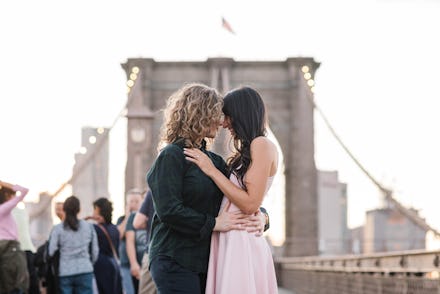Planning the big gay wedding I never dreamed of

If you follow semi-traditional wedding gender norms, a lesbian wedding is, by default, the most expensive type of wedding you could possibly plan.
There are potentially twice as many flowers (for brides and wedding party members), updos to style, faces to make up and outfits to buy. Even if wedding gowns aren’t in play, menswear-style suits that actually fit women are expensive.
Women, statistically, earn less than men, yet the costs associated with being female and fulfilling our prescribed roles in the world are significantly higher. And as I’ve started planning and paying for my own wedding, it’s become overwhelmingly obvious the ways that women are duped into believing we should spend the equivalent of a luxury vehicle or college tuition on a single day.
“You deserve to have your dream wedding, just like anyone else,” my cousin shouts at me over the ambient noise of people chatting and devouring tacos at a trendy Brooklyn restaurant.
“But the further I stepped away from that white dress and seating chart and tiered cake and first dance, the more I wanted it.”
“I never had a dream wedding,” I shout back after a sip of frozen margarita, sounding a little more aggressive than I probably intended, but also frustrated that I’ve continued to repeat this point to a bevy of wedding coordinators, dress consultants and countless other women — it’s almost exclusively women — involved in the endless whirl of the wedding-industrial complex.
I wasn’t ever sure I wanted a wedding. My fiancée and I discussed eloping. I brought forth the idea of getting married at city hall and treating our friends and family to unlimited dim sum in Chinatown. We played with various images of what it would mean to marry each other and celebrate that marriage, without falling into the trap of what we now understand as the workings of capitalism. But the further I stepped away from that white dress and seating chart and tiered cake and first dance, the more I wanted it.
While having a “real” wedding never seemed likely, and while I know fighting for same-sex marriage was not about fighting for the right to buy into all the bridal-branded nonsense, I still wanted in. I wanted all my loved ones in one place. Sad occasions are guaranteed — happy ones, we have to make for ourselves.
Some in favor of legalizing same-sex marriage made the argument that it would forcefully help the economy. That talking point may have initially been a more palatable way to sway conservatives into believing in the cause, but the numbers don’t lie. In 2016, a year after the United States officially made same-sex marriage legal, same-sex weddings were estimated to boost local economies by $1.5 billion, and provide thousands of new jobs. Capitalism and queerness have a tricky relationship, but the money speaks.
Still, there’s a huge gap in the market. My vision for my big gay wedding was to have 100% queer-owned everything, which, in practice, proved nearly impossible (especially when you’re not working with an unlimited budget). The venue my fiancée and I chose is owned by a very nice, very supportive straight couple. The only lesbian caterer wasn’t available. I couldn’t find any all-female or gay-fronted wedding bands within a reasonable distance of my venue. The only lesbian bridal boutique I could find was in small-town Massachusetts, and openly queer wedding dress designers are essentially nonexistent. The wedding industry, as an industry in itself, seems to still have a large gap for queer people vending wedding goods and services.
A strong cluster of businesses owned and operated by allies (many of which we’re happy to be working with) exists, but there’s room for so much more queer inclusion and representation within the industry. The marketing is still hugely heteronormative. Whether you’re looking for save the dates or organizing a registry or just browsing floral arrangements, nearly everything wedding-related is marketed with pictures of a bride and groom. Whenever a vendor doesn’t promptly return my email or phone call (a practice I’ve heard is actually common, despite my interest in literally throwing money at them), I wonder if it’s because they looked at my social media or found out I’m engaged to a woman and they don’t want to be involved in our wedding.
I know I’m being paranoid, but when you read about cases like the Masterpiece Cake Shop (along with several word-of-mouth stories about businesses much closer to us that refused to work on same-sex weddings) and see nothing other than opposite-sex couples on wedding vendors’ websites, the message feels clear: This isn’t for you.
And yet, as I’m debating dinner protein options with a caterer in the back of a cab in mid-day New York City traffic or discussing my fiancée’s wedding suit with my bridal consultant at Kleinfeld, I am triumphant; I am the heroine of my own lesbian wedding rom-com (that has yet to be produced).
Sure, I’ve bought into all the nonsense and overpriced everything that straight couples have worshipped for centuries, but I’ve bought into it with my (and my fiancée’s) money, earned as an independent, out adult in a world that once seemed too cruel for any of this to be possible. And while I realize my wedding planning bubble is in no way a reality for countless queer people getting married, it has become a strange, frustrating, challenging yet wholly absorbing dream wedding reality I never before quite believed in.